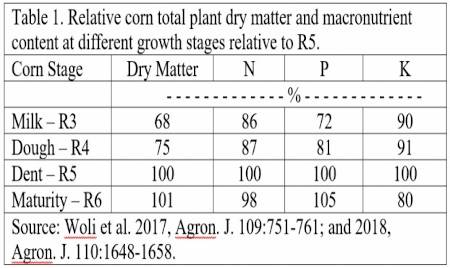By John Sawyer and Antonio Mallarino
The August 10, 2020 high winds (derecho) caused lodged or flattened corn in many Iowa fields. The corn development ranged mainly from stages R3 (milk) to R5 (dent). Some fields may not be harvested, some chopped for silage, and some harvested for grain. Nutrients such as nitrogen (N), phosphorus (P), and potassium (K) remaining in the field may be different than with normal harvest due to partial plant removal, grain harvest, or grazing. Therefore, adjustments can be made for future fertilizer or manure applications.
Effect of corn development stage
Iowa State University and Outreach publication PM 1688 (A General Guide for Crop Nutrient and Limestone Recommendations in Iowa) provides P and K concentrations for corn normally harvested for grain and corn silage. Additional information on dry matter and nutrient content of various corn vegetative components at maturity can be found in ICM News article Dry Fall Conditions Can Lead to Field Fires.
The corn plant P and K concentrations, as well as the N and dry matter concentrations, may differ with earlier growth stages. A recent ISU research study conducted across two years looked at the dry matter and nutrient content of several era corn hybrids. The following information is taken from the most modern hybrids in that study. Plant dry matter and nutrient content increases as reproductive stage and grain fill progresses (Tables 1 and 2). These values can be used as estimates/adjustments for the corn stage in specific fields. There tends to be nutrient loss from vegetative tissues as corn reaches maturity (R6 stage), therefore the total plant relative values are based on the total at R5. Such nutrient loss does not occur for grain, therefore, the grain relative values are based on the total at R6.
